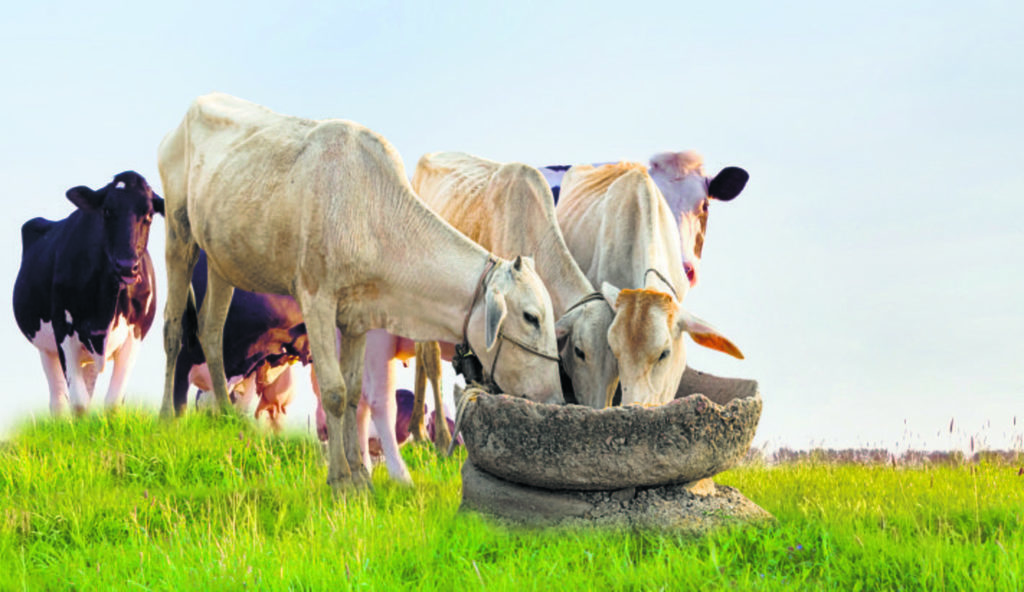The rice-wheat cropping system has not only attained its potential in Punjab but also led to the depletion of soil and water reserves of the state. The technology has shown signs of fatigue; the income growth has slowed down and employment has shrunk. In an era of declining farm income and a drop in employment opportunities, the livestock sector has emerged as an important sub-sector of Punjab’s agriculture. Livestock plays a significant role in the rural economy. It is one of the remunerative alternatives to the wheat-rice system which provides regular income and employment to the households, especially small and marginal farmers. This regular source of income acts as a cushion against the inclement weather-linked risks to seasonal income from the crop sector.
The contribution of the livestock sector to Punjab’s agriculture and allied GDP increased from Rs 727.08 crore (30 per cent) during 1980-81 to Rs 53,157.70 crore (40.6 per cent) during 2019-20. The sector has grown at the rate of 6.43 per cent in the last decade, far above the growth of the crop sector (0.46 per cent) during the same period. Till now, the growth in the dairy sector has been demand-based and self-driven. In spite of low public investment (low budgetary allocations) in the livestock sector, its growth rate is very consistent and has remained above 5 per cent in the past five decades. Punjab is the only state where the dairy production system is characterised by rural as well as modern commercial farms. Both are the backbone of the state’s dairy production system contributing 13.35 million tonnes (6.73 per cent) milk to the national pool of India (198.4 million tonnes) with only 2.16 per cent dairy animals. Cattle and buffaloes are the most relevant species for the state and these together accounted for 93 per cent of the total livestock population (2017 livestock census). The population of crossbred and indigenous cattle and buffaloes, as per this census, was 2.08, 0.43 and 4.42 million respectively. The share of buffalo is highest (70.63 per cent) in the total milk production of the state. Punjab stands first in per animal/kg/day milk yield of indigenous and crossbred cattle and second in the per animal/kg/day milk yield of buffaloes at the national level. The state also stands first in terms of per animal milk productivity as well as per capita milk availability (1,225 gm/day vs 407 gm/day) in the country.
The dairy sector has been in crisis since last year due to a steep hike in the prices of various inputs, especially feed and fodder. PDFA (Progressive Dairy Farmers’ Association) reports the closure of some dairy farms in the state. The increase in the rate of milk is not commensurate with the increase in the prices of inputs.
The main component of the cost of milk production is the feed cost — accounting for almost 75 per cent, which includes green fodder, dry fodder, concentrates and supplements. During the past year, the prices of all feed items have skyrocketed, including transportation and fuel costs.
Between March 2020 and March 2022, the prices of major ingredients used in concentrate feed have risen, resulting in 22-25 per cent increase in the concentrate feed cost.
The prices of dry roughage like wheat straw and paddy straw have also gone northwards, adding to the input cost of milk production. Wheat straw that used to be available for around Rs 500 per quintal is trading at Rs 1,250. Paddy straw, which is not very popular as animal feed and was sold at Rs 200-250 per quintal, is now quoted at Rs 500-550. Other than feed cost, the labour and diesel expenses also form important components of the cost structure. Apart from a hike in daily wage rates, the diesel prices have been high of late.
The situation can be improved if there is a commensurate rise in milk procurement rates as well, which should rather be linked to the input costs. Verka (Milkfed cooperative) is the trend-setter in determining the milk procurement price from producers. Its milk pricing yardstick is followed by other private aggregators for procuring milk from producers. Ironically, the farmers are getting the same rates for the milk produced from Verka as they were getting in January 2020, before the Covid pandemic struck the country. Resultantly, the rise in the procurement price of milk is far less than the rise in the cost of milk production. The prices announced by Milkfed increased by 7.81 per cent for cow milk and 9.09 per cent for buffalo milk during the past year. While private players like Nestle have not increased their prices in the past two years; still their prices are 8.46 per cent higher than Milkfed prices. This results in curtailment of the profit margins of dairy farmers, with mounting losses leading to the closure of farms. It is imperative that there is consonance between the cost of dairy inputs and the milk procurement price. In its absence, dairy farmers of the state continue to suffer.
Considering the importance of dairy farming in accelerating the growth of the agriculture sector and providing nutritious dairy products to the masses, there is an urgent need for a policy intervention for incentivising dairy farmers by way of increasing milk procurement rates by Verka or extending a special incentive on milk, as is being done in some states. The Rajasthan Government, under its flagship scheme called Mukhyamantri Dugdh Utpadak Sambal Yojana, is providing an incentive of Rs 5 per litre of milk to more than 9 lakh farmers associated with state milk cooperative societies. A budget of Rs 550 crore has been allocated for this scheme. On similar lines, the Punjab Government should support dairy farmers by giving subsidies on input costs and cash incentives on production amid the crisis.










